当前位置:网站首页>Redis highly available sentinel mechanism
Redis highly available sentinel mechanism
2022-07-05 12:18:00 【Xujunsheng】
Redis Highly available sentinel mechanism
The main library is down , How to provide uninterrupted service ?
In the previous article , We analyzed Redis A master-slave mode . In this mode , If the slave library fails , The client can continue to send requests to the master library or other slave Libraries , Carry out relevant operations . But if the main library fails , That directly affects the synchronization of slave libraries , Because there is no corresponding master database for data replication from the slave database .
if , All the requests sent by the client are read requests , Then you can continue to provide services from the library , This can also be accepted in the pure reading business scenario .
Once there is a write request , According to the read-write separation requirements in the master-slave library mode , The main library needs to complete the write operation . here , No instance can serve the client's write request , As shown in the figure below :
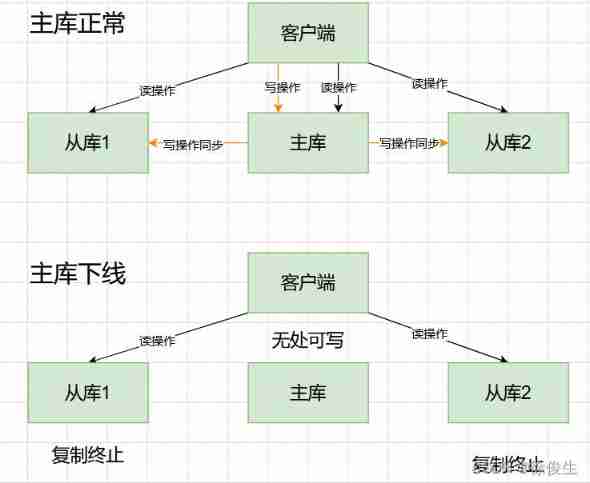
therefore , If the main library hangs , We need to run a new master library , For example, switch a slave library to a master library , Think of it as the main library .
There are three issues involved :
- Does the main library really hang up ?
- Which slave database should be selected as the master database ?
- How to inform the slave library and client of the relevant information of the new master library ?
So that's the point Sentinel mechanism 了 .
stay Redis Master slave cluster , Sentry mechanism is the key mechanism to realize automatic switch between master and slave , It effectively solves the three problems of failover in master-slave replication mode .
Sentinel mechanism
sentry (Sentinel) yes Redis High availability solutions , It's really just A that runs in a special mode Redis process , When the master-slave database instance is running , It's running, too .
By one or more Sentinel Examples of Sentinel The system can monitor multiple master servers , And all the slave servers under these master servers , And when the monitored master server goes offline , Automatically upgrade a server under the offline master server to a new master server , Then the new master server will replace the offline master server to continue processing the command request .<<Redis Design and implementation >>
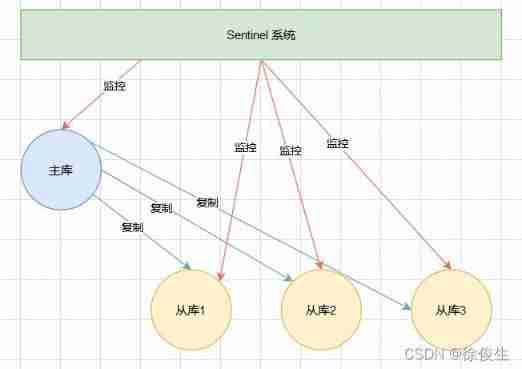
Get master server information
Sentinel By sending INFO Command to obtain the current information of the master database and the information of all slave databases of the master database . As shown in the figure below :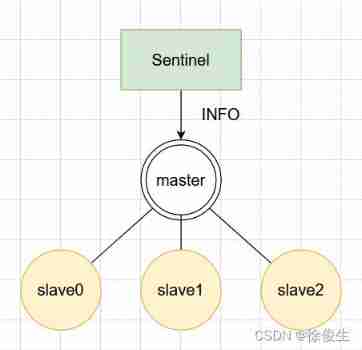
When Sentinel After discovery from the Library ,Sentinel Will be right slave0、slave1 and slave2 Create command connection and subscription connection respectively .
After creating the command connection ,Sentinel Will send to the slave Library INFO command Get the following information :
- From the run of the library id;
- From the role of the Library
- The main library ip And port number ;
- The connection status of the main library ;
- From the priority of the library
- Copy offset from library
Based on this information ,Sentinel The instance structure of the slave library will be updated .
I understand Sentinel How to get the information of master and slave libraries , Now let's analyze the basic process of sentinel mechanism .
The basic process of sentry mechanism
The sentry is mainly responsible for three tasks : monitor 、 Elector ( Select the master library ) And notify the .
- monitor : adopt
PINGTo monitor the master-slave server ; - Elector : The main library is down , Select a new master library in the slave library according to a certain mechanism ;
- notice : Inform other slave libraries and the client about the new master library ;
Let's look at the surveillance first .
monitor
By default , The sentinel will send to all master and slave libraries at a frequency of once per second PING command , Check if they are still running online .
Sentinel In the configuration file down-after-millisenconds Indicates that the sentinel judges that the instance enters Subjective offline The length of time required .
If an example is in down-after-millisenconds In milliseconds , In succession Sentinel Return invalid reply , that Sentinel You will think that this instance has entered Subjective offline state .
Carefully, the classmate noticed , What we are talking about here is subjective offline . The sentinel has a problem with the offline judgment of the main library Subjective offline and Objective offline Two kinds of .
that , Why are there two kinds of judgments ? What are their differences and connections ?
Subjective offline and objective offline
Subjective offline : The sentinel process will use PING The command detects itself and the master 、 Network connection of slave library , Used to determine the state of an instance .
If the sentry finds the master or slave library to PING The response to the command timed out , that , The sentinel will mark it as 「 Subjective offline 」.
If it's a slave Library , that , The sentry simply marked it as 「 Subjective offline 」 That's it , Because the offline effect of the slave library is not too big ,
The external service of the cluster will not be interrupted .
however , If it's a master library , that , The Sentry can't simply mark it as 「 Subjective offline 」, Turn on the master-slave switch . Because it's possible that there is such a situation : That's the sentry Miscalculation 了 , In fact, there is no fault in the main database .
and , Once the master-slave switch is started , Subsequent selection and notification operations will bring additional computational and communication overhead . To avoid these unnecessary expenses , We need to pay special attention to misjudgments .
Miscalculation
Misjudgment is that the main database is actually not offline , But the sentry mistakenly thought it was offline .
Miscalculation usually occurs when the cluster network is under great pressure 、 Network congestion 、 Or when the main reservoir itself is under high pressure .
Once the sentinel decides that the main vault is offline , You'll start selecting the new master library , And let the slave database and the new master database to synchronize data , The process itself has costs .
for example , The sentinel will take time to select the new master library , The slave also takes time to synchronize with the new master .
And the truth is , The main database itself does not need to be switched , So the cost of this process is worthless .
Because of this , We need to judge if there is a miscalculation , And reduce misjudgment .
How to reduce miscarriage of Justice ?
In everyday life , When we have to judge something important , I often discuss it with my family or friends , Then make a decision .
The sentry mechanism is similar , We usually deploy in a cluster mode composed of multiple instances , Also known as sentinel clusters .
Introduce several sentinel examples to judge together , You can avoid a single sentry because your network is not good , And misjudge that the main database is offline .
meanwhile , The probability of multiple sentinel networks being unstable at the same time is small , They make decisions together , The miscalculation rate can also be reduced .
When Sentinel After judging a main database as subjective offline , In order to confirm whether it is misjudged , It will also monitor the main library to other Sentinel ask . Only most sentinel instances , It is judged that the master database has 「 Subjective offline 」 了 , The main database will be judged as 「 Objective offline 」, This name also shows that the offline of the main database has become an objective fact .
This judgment condition lies in Sentinel Configuration quorum The value of the parameter , If Sentinel The configuration is as follows :
sentinel mointor master 127.0.0.1 6379 2
So as long as there are two Sentinel It is considered that the main library has entered the offline state , Then the main database is judged as 「 Objective offline 」.
Generally speaking , When there is N A sentinel instance , It's better to have N/2 + 1 The main database is 「 Subjective offline 」, In order to determine the main database as 「 Objective offline 」.
thus , You can reduce the probability of miscalculation , It can also avoid unnecessary master-slave switch caused by misjudgment .
With the help of the common judgment mechanism of multiple sentinel instances , We can more accurately determine whether the main database is offline . If the main library is offline , The sentinel is about to start the next decision-making process , That is, from many repositories , Select a slave library to be the new master library .
Then there is the second task of the sentinel , Elector .
How to select a new main library ?
After the main warehouse is hung ,Sentinel You need all slave libraries under the offline master database , Pick out one in good condition 、 Complete data from the Library , Make it the new main library .
After this step is completed , Now there is a new main database in the cluster .
Generally speaking , We put Sentinel The process of selecting a new master database is called 「 Screening + Scoring 」.
Simply speaking , We're in multiple repositories , First according to Certain screening conditions , Filter out the unqualified ones from the Library .
then , We'll follow Certain rules , Score the rest from the library one by one , Select the slave database with the highest score as the new master database .
Let's first look at the screening conditions .
filter
Sentinel All slave libraries under the offline master database will be saved to a list . Then follow the following rules , Screening :
1)、 In general , We must ensure that the selected slave library is still running online , So first, you need to delete the slave libraries that are offline or disconnected in the list .
however , When selecting master, slave database is online normally , This only means that the slave database is in good condition , It doesn't mean that it is the most suitable for the master library .
imagine , If in the election , A slave library works normally , We chose it as the new master library and started using it . But , Soon its network broke down , here , We're going to have to re elect . This is obviously not what we expect .
therefore , In the election , In addition to checking the current online status of the slave Library , We also need to judge the network connection status before it .
2)、 Delete all recent... From the list 5 I haven't replied in seconds INFO Command slave , This can ensure that the remaining slave libraries have successfully communicated recently .
3)、 If the slave database is always disconnected from the master database , And the number of disconnection times exceeds a certain threshold , We have reason to believe that , The network condition of this slave database is not very good , You can sift this out of the library .
How to judge specifically ?
Use configuration items down-after-milliseconds * 10 .
among ,down-after-milliseconds It is the maximum connection timeout that we determine that the master-slave database is disconnected .
If in down-after-milliseconds In milliseconds , The master and slave nodes are not connected through the network , We can think that the master-slave node is disconnected . If the disconnection occurs more than 10 Time , This shows that the network condition of the slave database is not good , Not suitable as a new master library .
Okay , In this way, we filter out the slave database that is not suitable for the master database , The screening is done .
Scoring
The next step is to grade the rest of the slaves . We can grade three rounds according to the three rules , The three rules are From library priority 、 Copy progress from library and from library ID Number .
Just in one round , The highest score from the library , So it's the main library , This concludes the selection process . If there is no slave with the highest score , So go on to the next round .
The first round : The one with the highest priority gets the highest score from the database .
We can go through slave-priority Configuration item , Set different priorities for different slaves .
slave-priority 100
such as , You have two slaves , They have different memory sizes , You can manually set a high priority for instances with large memory .
In the election , Sentinels will give high priority slaves high marks , If there is a slave library with the highest priority , So the main library is the new one .
If the priority of the slave library is the same , So the sentry begins the second round of scoring .
The second round : The highest copy offset is obtained from the Library .
The rule is based on , Sort all slave libraries with the same highest priority , Select the slave database with the largest offset, that is, the one closest to the data synchronization of the old master database, as the master database .
How to judge the synchronization progress between the slave database and the old master database ?
We mentioned in the previous article , There is a command propagation process during master-slave synchronization .
In the process , The main library will use master_repl_offset Record the current latest write operation in repl_backlog_buffer Position in ,
And from the library will use slave_repl_offset This value records the current replication progress .
here , What we're looking for is from the library , its slave_repl_offset Need to be closest to master_repl_offset.
If in all slave Libraries , There are... From the library slave_repl_offset Nearest master_repl_offset, Then its score is the highest , It can be used as a new main library .
As shown in the figure below , From the old main library master_repl_offset yes 1000,
Slave Library 1、2 and 3 Of slave_repl_offset Namely 950、990 and 900, that , Slave Library 2 Should be selected as the new master library .
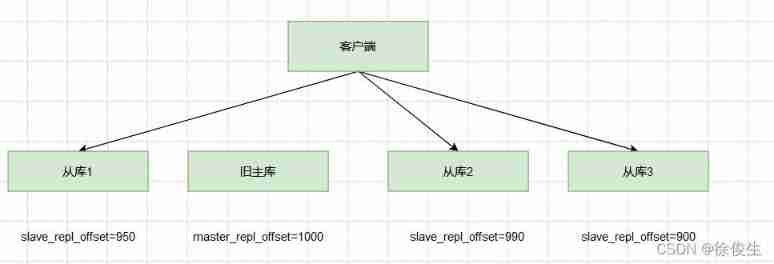
If there are two from the library slave_repl_offset The value size is the same ( for example , Slave Library 1 And from the library 2 Of slave_repl_offset Values are 990),
We need to score them in the third round .
The third round : function ID The smallest score from the Library .
Each instance will have a ID, This ID It's similar to the slave library number here . at present ,Redis When selecting the master database , There is a default rule :
With the same priority and replication schedule , function ID The one with the smallest number gets the highest score from the library , Will be selected as the new master library .
Come here , The new master library was selected ,「 Elector 」 This process is done .
Let's review the process again :
- First , The sentinel will be on line 、 Network state , Filter out a part of the library that does not meet the requirements ;
- then , In order of priority 、 Replication progress 、ID Number size and then score the rest of the slave library , As long as there is the highest score from the library , Choose it as the new main library .
notice
When the new main database appears , next step , The Sentry will perform the last task : notice . That is, let all slave libraries that have been offline copy the new master database .
By letting the slave execute slaveof command , Connect to the new master library , Data replication .
meanwhile , The sentinel will notify the client of the connection information of the new main database , Let them send the request operation to the new main library . And the offline master database will be set as the slave database of the new master database .
Okay , We have analyzed the basic process of sentinel mechanism work here . If you want to see more quality original articles , Welcome to my official account. 「ShawnBlog」.
边栏推荐
- Hiengine: comparable to the local cloud native memory database engine
- A new WiFi option for smart home -- the application of simplewifi in wireless smart home
- MySQL index - extended data
- Which domestic cloud management platform manufacturer is good in 2022? Why?
- Halcon template matching actual code (I)
- Swift - enables textview to be highly adaptive
- The most comprehensive new database in the whole network, multidimensional table platform inventory note, flowus, airtable, seatable, Vig table Vika, flying Book Multidimensional table, heipayun, Zhix
- Principle of redis cluster mode
- [untitled]
- 【load dataset】
猜你喜欢
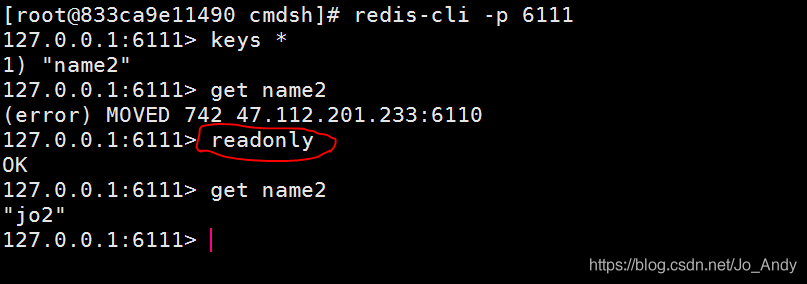
Simply solve the problem that the node in the redis cluster cannot read data (error) moved
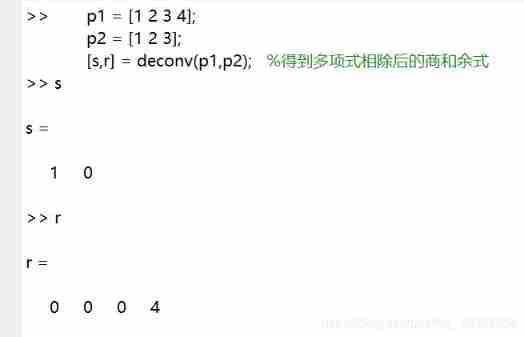
Four operations and derivative operations of MATLAB polynomials
![[configuration method of win11 multi-user simultaneous login remote desktop]](/img/8f/eab81f089b236c4527a9866b2cfc25.png)
[configuration method of win11 multi-user simultaneous login remote desktop]

Error modulenotfounderror: no module named 'cv2 aruco‘
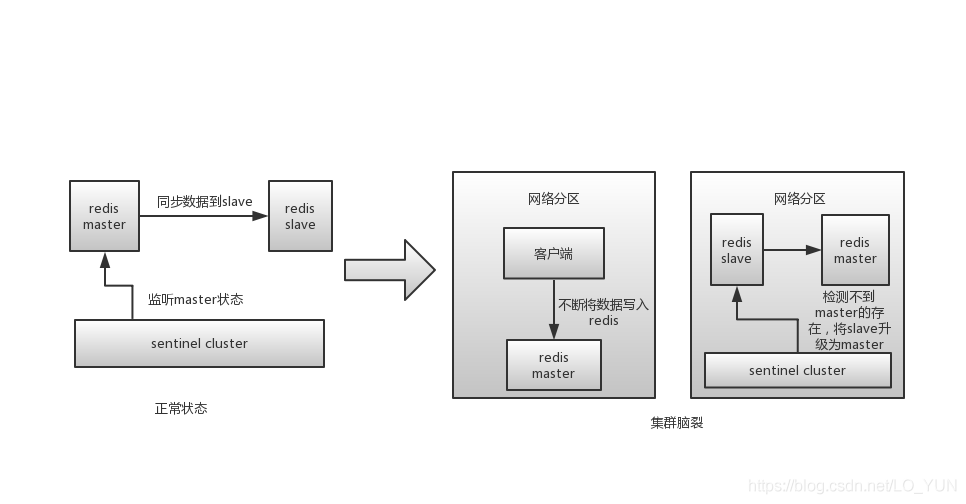
Redis cluster (master-slave) brain crack and solution

Hiengine: comparable to the local cloud native memory database engine

7月华清学习-1

Riddle 1
Why do you always fail in automated tests?
![[pytorch modifies the pre training model: there is little difference between the measured loading pre training model and the random initialization of the model]](/img/ad/b96e9319212cf2724e0a640109665d.png)
[pytorch modifies the pre training model: there is little difference between the measured loading pre training model and the random initialization of the model]
随机推荐
【load dataset】
Learn the memory management of JVM 03 - Method area and meta space of JVM
Codeworks 5 questions per day (1700 average) - day 5
Intern position selection and simplified career development planning in Internet companies
Flutter2 heavy release supports web and desktop applications
Reinforcement learning - learning notes 3 | strategic learning
MySQL data table operation DDL & data type
Tabbar configuration at the bottom of wechat applet
Image hyperspectral experiment: srcnn/fsrcnn
Why do you always fail in automated tests?
Learn garbage collection 01 of JVM -- garbage collection for the first time and life and death judgment
Codeforces Round #804 (Div. 2)
Basic operations of MySQL data table, addition, deletion and modification & DML
Four operations and derivative operations of MATLAB polynomials
语义分割实验:Unet网络/MSRC2数据集
你做自动化测试为什么总是失败?
Conversion du format de données GPS [facile à comprendre]
Seven ways to achieve vertical centering
Instance + source code = see through 128 traps
Recyclerview paging slide
